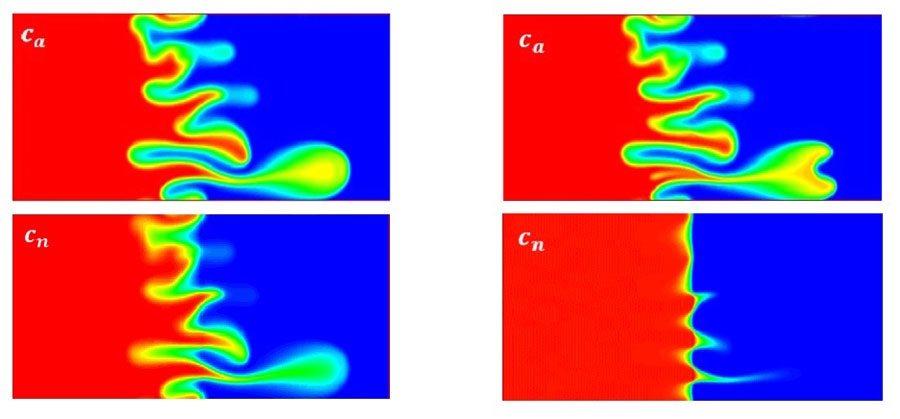Apr 5 2017
 Countours of ca and cn at two nanoparticle deposition rates at t=400 (Credit: Dastvareh and Jalel Azaiez)
Countours of ca and cn at two nanoparticle deposition rates at t=400 (Credit: Dastvareh and Jalel Azaiez)
Individuals who have combined vinegar and oil may have unknowingly observed a weird fluid phenomenon known as fingering instability. This type of phenomenon, known as viscous fingering (VF), takes place in porous media where fluids of varying viscosity meet in finger-shaped patterns due to increasing disturbances at the interface.
Such type of instabilities can be seen in different types of fields. Applications like contaminant transport in soil, where a fluid is injected to displace contaminants or oil, or the oil recovery process, require a uniform fluid front to attain the highest volumetric sweep and effectiveness, and hence such instabilities are considered to be undesirable.
However, in micromixers and other similar microfluidic devices where inertial effects are insignificant, the VF phenomenon provides an effective way to improve the fluids’ mixing rate. As a result, a better insight into different aspects of this phenomenon, and the variables that regulate things like velocity distribution dynamics and instabilities, could provide more options to control and use these effects in a more effective way.
Researchers at the University of Calgary have long been studying this area of interest and have made excellent advancements in understanding the phenomenon. The results of the study have been reported in the journal Physics of Fluids, from AIP Publishing.
My work is part of the puzzle in the evolution in this research area. My research allows me to combine my interest in mathematics, numerical methods and fundamental research in transport phenomena, and particularly fluid mechanics.
Benham Dastvareh, Researcher, University of Calgary
The Calgary team used a comprehensive approach, which involved incorporating the nonlinear simulation of the growing fingers as well as the analytical stability analysis of nanofluid displacement within a porous media. When the researchers combined the benefits of these methods, they were able to gain better and more detailed understanding of the fluid phenomenon.
Although results showed that nanoparticles are incapable of making a stable flow unstable, they can attenuate or improve the instability of an originally unstable flow. The flow was destabilized when the deposition rate or diffusion rate of nanoparticles was increased.
In addition, deposition of nanoparticles can alter an initial monotonically decreasing viscosity distribution—one that is purely unchanging or decreasing, to a non-monotonic viscosity distribution, and causes the development of vortex dipoles.
Analyses of vortex structures along with the viscosity distributions allowed us to explain the observed trends and the resulting finger configurations. This work opens a gate for further studies and represents new findings that can be used to control the growing instabilities in the presence of nanofluids for different applications.
Benham Dastvareh, Researcher, University of Calgary
The study also holds immense potential for drug delivery, where nanoparticles cannot easily pass through a porous medium. “It is possible that viscous fingering could be used to open a channel in the human tissue to transfer these nanoparticles for clinical treatment,” Dastvareh said.